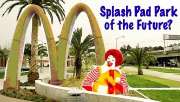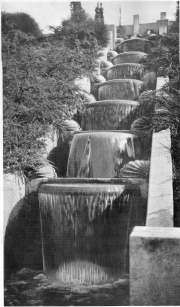Petri dish for growth
Buying a house above Lake Merritt was the beginning of a transformation for me much broader that merely becoming a homeowner.
Oakland is a city of neighborhoods, and the Greater Grand Lake neighborhood into which we moved deservingly inspires appreciation and pride, warrants loyalty, and provokes the protective instinct.
And our house — a 1923 Prairie Style or perhaps, more specifically, an American Foursquare — grand and lovingly maintained, dates back to the beginning of its Haddon Hill neighborhood.
This new context led ultimately to my strong interests in the historic architecture of the East Bay, Art Deco, and Oakland’s history; which manifested in my active engagement in historic preservation and restoration, neighborhood activism, and city politics.
Fending off McDonald’s
My very intense baptism as a neighborhood activist began in December 2003 when word got out that McDonald’s was planning to invade a vulnerable and vital stretch of Lake Park Avenue.
I joined a core team of a dozen wonderful, creative, talented, experienced, savvy, and indefatigable neighborhood activists spearheading the community’s opposition. Each of us brought different and complementary experiences and skill sets to the enterprise. Our efforts meshed like clockworks gears in a very gratifying and satisfying egoless collaboration.
In the short form of this story… hundreds of protestors and thousands of signatures later, with a dash of innovative, yet rigorous, legal reasoning, and a pinch of lobbying, the combination of massive public pressure, along with proving that the law was on our side, lead to eventual victory against the golden arches.
Restoring a local treasure
When I discovered it, the Cleveland Cascade was a narrow, well shaded, very steep park leading from the top of my hill down to Lake Merritt. Though it was pretty dilapidated and obviously uncared for, the pair of stairways connecting top and bottom attracted excercisers in search of an extreme workout — their energy and ambition brought life to an otherwise somewhat sad park.
The “Cleveland” part of its name made sense: the park was an extension of what would have been Cleveland Street had it not been too steep for cars. But “Cascade”? There was no hint of flowing water ever. Then in the spring of 2004 Barbara Newcombe visited the Environmental Design Library at UC Berkeley and uncovered this photo — and that blew our minds.
A couple of weeks later, during a May Day work party officially intended only to clean and spruce up the park, inspired by the photo I took a long piece of hangar wire and a shovel to the top. Based on clues in the photo, confirmed by probes with wire, I started to dig out the rosemary bushes that had secretly been standing sentinel over a buried 1923 cascading water fountain, envisioned and built by Howard Gilkey in 1923. Brian Roberts immediately joined me. After the first of 20 basins was revealed, others joined in, deploying up and down the slope. At the end of the third weekend, the original cascade, though gravely injured, was revealed once again.
Now the City of Oakland has allocated $300,000 of Measure DD bond money toward the park’s restoration, we’re raising money on top of that, and we’re working hard toward a full restoration of the cascading fountain. To continue this story, check out clevelandcascade.org.

The Grand Lake Theater, a neighborhood landmark that frequently sacrifices part of its marquee to voice the sentiment of the community

My nightmare fantasy of Splash Pad Park after McDonald’s invades. (This still hangs on the door of a City Council staffer)

